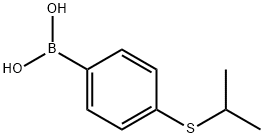
4-ISOPROPYLTHIOPHENYLBORONIC ACID synthesis
- Product Name:4-ISOPROPYLTHIOPHENYLBORONIC ACID
- CAS Number:380427-38-3
- Molecular formula:C9H13BO2S
- Molecular Weight:196.07

70398-89-9
43 suppliers
$28.28/250mgs:

380427-38-3
136 suppliers
$24.00/1g
Yield: 90%
Reaction Conditions:
Stage #1:1-bromo-4-(1-methylethylthio)benzene with n-butyllithium in tetrahydrofuran;hexanes at -78 - -40; for 0.5 h;
Stage #2: with Triisopropyl borate in tetrahydrofuran;hexanes at 20;
Stage #3: with hydrogenchloride;potassium hydroxidemore than 3 stages;
Steps:
14
Dissolve 4-bromo-benzenethiol (1. 0 g, 5.3 mmol) in dry dimethylformamide (50 mL) and cool to 0°C under nitrogen. Add dry sodium hydride (153 mg, 6. 4 mmol) in portions. After the vigorous gas evolution stops, add 2-bromo-propane (0. 60 mL, 6.4 mmol) and stir the reaction overnight at room temperature. Slowly pour the reaction into water (300 mL) and extract with ethyl acetate (2x150 mL). Wash the combined organic layers with water (100 mL) and brine (100 mL). Dry the organic layer with sodium sulfate, filter and concentrate in vacuo. Chromatograph the resultant residue on a SiO2 column with 5% ethyl acetate in hexanes to yield l. lg of 1-bromo-4-isopropylsulfanyl- benzene (92%). XDissolve l-bromo-4-isopropylsulfanyl-benzene (2.5 g, 10.8 mmol) in dry tetrahydrofuran (100 mL) and cool the solution to-78°C. Add 2. 5 M n-butyllithium in hexanes (5.2 mL, 12.9 mmol) dropwise and allow the reaction to warm to-40°C and stir for 30 minutes. Cool the reaction to-78°C and add triisopropyl borate (7. 4 mL, 32. 4 mmol) and allow the reaction to slowly warm to room temperature. Add 10% aqueous potassium hydroxide (96 mL, 172 mmol) and stir overnight. Slowly pour the reaction into a mixture of concentrated HC1 and ice. Extract the aqueous solution with dichloromethane, dry with sodium sulfate and concentrate in vacuo to yield 1.9 g of the title compound (90%).
References:
ELI LILLY AND COMPANY WO2004/9086, 2004, A1 Location in patent:Page/Page column 42-43